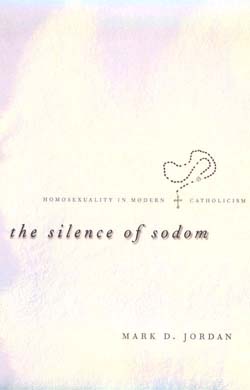
|
The Silence of Sodom: Homosexuality in Modern Catholicism By Mark D. Jordan. Chicago: University of Chicago Press, 2000. Paperback, 322pp.
Now that the paperback edition has appeared, the most important contribution to understanding the current position of Roman Catholicism on the issue of homosexuality is available at a more reasonable price. And in spite of the fact that the book may at times sound like the work of a professor (Jordan is Asa Griggs Candler Professor of Religion at Emory University), it is worth working through those few but brief passages. LGBT people who feel attached to the Church or for some reason a need to stay with it must reflect on Jordan's insightful, non-sugar-coated, realistic analysis of the rhetoric of the Church's official statements and the reality he exposes: that the modern Roman catholic Church has not actually moved ahead on this issue. The official position of the Church, this historian of Roman Cathlicism says, has actually become more rabidly anti-gay. This has to be disappointing for LGBT people who are hoping for better or who would rather remain in denial about the Church. They may prefer not to face Jordan's expose and their feelings about this matter. Jordan looks carefully, for example, at one of the seemingly positive statements: the 1997 letter from American bishops called Always Our Children: Pastoral Message to Parents of Homosexual Children and Suggestions for Pastoral Ministers. He concludes that even before it was officially revised to be less accepting by the Vatican's archconservative Congregation for the Doctrine of the Faith in 1998, "Always Our Children echoes the anti-homosexual rhetoric of the 'Christian Right'…." (p.46) Jordan also traces the short history of Dignity, an organization for gay Catholics who attempt to remain in the Church and change the Church's anti-gay position. The organization is another one of those hopes clung to by LGBT hangers-on. But it was soon margnialized and is now floundering. "Perhaps Dignity will survive its present confusion, Jordan concludes. "But for the moment it lives on the edge of its seat, waiting to be invited onto the next flight to Rome." (p. 253). At this point, however, its future as an organization within the Church looks dim. The real issue is the book's major point. The intrinsic culture of Roman Catholic orders and its priesthood is tied to the Church's homosexual fixation, its homoerotic imagination, and the connection of these to the exercise of power in the definition of the priesthood. The Church's tedious on-going rhetoric about homosexuality is geared to maintain confusion and keep LGBT advocates busy and at bay. At the same time, the internal priestly culture consists of an unspoken queerness. Priests are called to display and act in all the ways Western European cultures consider "sissy, faggy, queer, and gay" (Look at how priests, bishops, and even Vatican leaders dress at the mass, or look at the fabulous display of the high mass itself.). But the fact that many priests, bishops, and others are gay, including those who are keeping the closet door closed, locked, and exclusive, must never be spoken. This gayness of priestly culture ("clerical camp") explains why the Church is more concerned with gay men than lesbians. It also explains the emotional needs fulfilled by the closeted gays in hierarchy as dominant men disciplining those at the bottom. To protect itself, the Church must always portray LGBT people as outside its ranks, as outsiders looking in. And keeping them outside is essential to the Church's image and its politics. That's Jordan's main point. The question for him as a "gay Catholic," then, is, why would anyone stay? Put another way, gay men "should ask not only what reasons they have for staying, but what erotic inducements the church uses to make them want to say." (p. 213) At this point the Vatican has mostly ignored the book hoping it will go away with all LGBT parishioners. Many LGBT Roman Catholics might wish to do ignore it too. But Jordan is asking an important question for any religious person: Why stay with an institution that abuses you? Sadly, the answers LGBT people often give are the same answers abused spouses give for staying with their abusers. Asking such questions and facing the realities of anti-gay religions make books like The Silence of Sodom important and often difficult reading.  Robert N. Minor is author of Scared Straight: Why It's So Hard to Accept Gay People and Why It's So Hard to Be Human (St. Louis: HumanityWorks!, 2001), Professor of Religious Studies at the University of Kansas, and a Midwest Times staff writer.
Robert N. Minor is author of Scared Straight: Why It's So Hard to Accept Gay People and Why It's So Hard to Be Human (St. Louis: HumanityWorks!, 2001), Professor of Religious Studies at the University of Kansas, and a Midwest Times staff writer.
|
|
 When the hardcover edition of The Silence of Sodom appeared two years ago, it was the subject of thorough scrutiny by LGBT scholars with experience in the Roman Catholic Church. An entire session of the annual professional meeting of religion professors in 2001 was devoted to it. The scholars and attendees, gay and straight, who participated in the meeting universally hailed Professor Jordan's analysis of the contemporary situation in Roman Catholicism as brilliant.
When the hardcover edition of The Silence of Sodom appeared two years ago, it was the subject of thorough scrutiny by LGBT scholars with experience in the Roman Catholic Church. An entire session of the annual professional meeting of religion professors in 2001 was devoted to it. The scholars and attendees, gay and straight, who participated in the meeting universally hailed Professor Jordan's analysis of the contemporary situation in Roman Catholicism as brilliant.